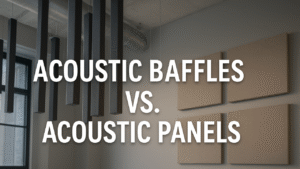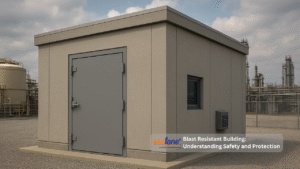Building Acoustics for Quiet, Productive Office Spaces
Modern workplaces are evolving quickly, and one important factor influencing performance is Building Acoustics. Whether it’s an open-plan office or a modern modular workspace, the way sound behaves inside a building has a direct impact on focus, comfort, and efficiency. As companies shift to hybrid work environments and recognize the need for healthy interiors, quiet and well-managed sound environments are becoming essential.
Effective Acoustic Control in Buildings ensures that offices remain free from unwanted noise, disruptive echoes, and speech spillover. By managing sound transmission and reflection, workplace design becomes more supportive of concentration and communication. Organizations aiming for long-term employee well-being increasingly prioritize acoustics as a foundational part of office planning.
This blog explains how acoustics influence office productivity, the science behind sound behavior inside buildings, real-world applications, and strategies to create acoustically balanced workplaces. Ecotone Systems continues to highlight the importance of sound-engineered environments that support daily tasks and overall employee comfort.
TABLE: Key Acoustic Elements vs. Impact on Productivity
| Element | Description | Impact on Productivity |
| Sound Absorption | Materials that reduce reflections and echo. | Supports focus and reduces distractions. |
| Sound Insulation | Barriers that block sound between rooms. | Enhances privacy and minimizes disturbance. |
| Reverberation Control | Managing how long sound remains in a space. | Makes meetings clearer and communication easier. |
| Acoustic Zoning | Planning spaces based on noise levels. | Improves workflow and comfort. |
| Vibration Control | Reducing structural vibrations. | Helps sensitive work areas remain stable. |
Understanding the Science of Quiet Workplaces
Sound inside a building behaves differently depending on materials, layout, and construction. A workspace with untreated surfaces will reflect sound, amplify conversations, and make even small noises feel intrusive. Acoustics solve these issues by controlling how sound moves and how long it lingers.
1. Sound Transmission
Walls, ceilings, and floors can carry noise into workstations. Without proper insulation, conversations from one area can easily disrupt others.
2. Reverberation Time
Long reverberation creates echoing environments, making voices unclear and increasing discomfort in meeting rooms or cafeterias.
3. Background Noise
HVAC systems, equipment, and nearby traffic can elevate noise levels beyond comfortable limits.
4. Vibration
Vibrations from machinery or nearby activity can impact comfort. This is especially important in advanced structures such as a Blast Resistant building, where stability and comfort must be maintained together.
Understanding these acoustic elements helps designers create more effective work environments.
How Good Acoustics Improve Productivity
Acoustic comfort supports employee performance in several meaningful ways.
1. Better Focus and Fewer Distractions
Noise is one of the biggest barriers to concentration. Ringing phones, conversations, movement, and office machinery can interrupt deep-work cycles. Acoustic treatments reduce these disturbances, helping employees stay focused for longer periods.
A quieter environment reduces mental fatigue, enhances clarity of thought, and leads to consistently higher-quality output.
2. Clearer Communication and Effective Meetings
Meetings and collaborative work require sound clarity. If the room echoes or outside noise seeps in, discussions take longer and misunderstandings increase.
By managing reverberation and controlling noise transfer, meeting rooms become more efficient spaces for communication. Enhanced clarity speeds up decision-making and reduces repetition.
3. Healthier and Less Stressful Work Environment
Uncontrolled noise increases stress levels and impacts overall well-being. Employees working in loud environments often report tension, headaches, or low energy.
Good acoustic planning creates a calming environment that supports mental health and day-to-day comfort. Over time, acoustic comfort contributes to workplace satisfaction and improved morale.
4. Improved Privacy and Confidentiality
Human resource discussions, leadership planning, client calls, or sensitive technical conversations require privacy. Insulated partitions and thoughtful zoning prevent speech from traveling where it shouldn’t.
Workplaces using specialized structures such as Blast Proof Modular Buildings also benefit from enhanced privacy due to denser construction and well-designed interiors.
5. Flexibility in Workplace Layout
Modern offices are diverse—focus rooms, collaborative hubs, lounges, and open areas all exist under one roof. Effective acoustic planning ensures each space works efficiently for its intended purpose without disturbing others.
This flexibility supports hybrid operational models and makes it easier for teams to adapt spaces over time.
Techniques and Solutions for Acoustic Improvement
Several strategies help create quieter, more comfortable workplaces.
1. Acoustic Wall Panels
These panels absorb reflections and reduce echo, improving comfort in open offices and meeting rooms.
2. Acoustic Ceilings
Suspended ceiling systems help manage reverberation in large or high-ceiling spaces.
3. Sound-Absorbing Flooring
Materials such as carpet tiles or acoustic vinyl help reduce footstep noise and vibration transfer.
4. High-Performance Partitions
Glass partitions, insulated drywall, and modular barriers provide privacy without compromising visual openness.
5. Acoustic Zoning
Dividing spaces based on noise levels—quiet areas, collaborative sections, and active spaces—keeps the office balanced.
6. Sound Masking Systems
Soft background noise can help mask disruptive conversations and enhance privacy.
7. Vibration Management
Floating floors and vibration pads are useful in specialized areas or secure work environments.
Acoustics in Specialized Office Structures
While acoustics are crucial in general workplaces, specialized buildings require even more detailed design considerations. In protective or industrial environments—such as a Blast Resistant building—interior acoustics must be approached carefully to ensure comfort isn’t compromised by structural requirements.
These buildings typically have dense walls and secure framing systems. Proper acoustic planning helps ensure reduced vibration, comfortable reverberation levels, minimal echo, and improved speech privacy.
Modular protective structures like Blast Proof Modular Buildings also benefit from acoustic improvements because they are often used for technical operations or secure workspace setups.
The Role of Ecotone Systems
Ecotone Systems provides advanced acoustic solutions that support high-performance workplaces. Their focus on engineering-driven design helps companies create environments where teams can work comfortably, collaborate effectively, and remain focused throughout the day.
Their solutions are widely used in offices, hybrid workspaces, modular setups, and secure facilities. With research-backed materials and modern acoustic planning, Ecotone Systems continues to support organizations that want improved workplace quality.
Why Acoustics Improve Business Performance
Investing in acoustic comfort has direct benefits for businesses.
- Better work quality
- Higher concentration and efficiency
- Reduced errors
- Improved employee satisfaction
- Stronger brand image
- Lower stress and fatigue
- More productive meetings
- Healthier long-term work environment
Quiet and balanced workplaces directly contribute to long-term organizational success.
Practical Improvements for Offices
Here are actionable changes workplaces can implement easily:
- Install acoustic panels in loud zones
- Add ceiling baffles for large rooms
- Use carpets or soft flooring in walkways
- Incorporate insulated partitions between desks
- Add plants for natural sound diffusion
- Create separate zones for high-activity areas
- Conduct a professional acoustic audit
These small improvements create noticeable changes in daily comfort.
Future Trends in Workplace Acoustics
Acoustic technology continues to evolve. Some emerging trends include:
- Smart sound-absorbing materials
- Adaptive acoustic systems
- Modular acoustic pods for privacy
- Integration of acoustics in hybrid workspace design
- Multi-functional acoustic furniture
- AI-based noise monitoring systems
Companies adopting these innovations will build quieter, healthier, and more efficient work environments.
Conclusion
A well-designed acoustic environment supports productivity, focus, and employee well-being. Good acoustics help reduce distractions, improve communication, support privacy, and create a calm workspace that enhances daily performance. This is true for standard offices as well as specialized environments that require resilient structures or advanced modular systems.
With thoughtful planning and the right materials, workplaces can become more comfortable, efficient, and future-ready. Acoustic comfort is no longer optional—it is an essential part of modern office design that supports every individual working inside it.





